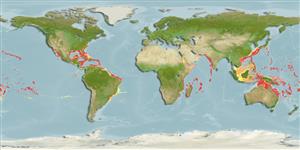Echinoneus cyclostomus (Leske, 1778)
Little burrowing urchin| Native range | All suitable habitat | Point map | Year 2050 |

|
| This map was computer-generated and has not yet been reviewed. |
| Echinoneus cyclostomus AquaMaps Data sources: GBIF OBIS |
Google image |
No photo available for this species.
Classification / Names Populärnamn | synonymer | CoL | ITIS | WoRMS
Echinoidea | Echinoneoida | Echinoneidae
Environment: milieu / climate zone / djupintervall / distribution range Ekologi
; djupintervall 0 - 570 m (Ref. 820). Tropical
Distribution Länder | FAO områden | Ekosystem | Förekomster | Utplanteringar
Indo-Pacific and Western Central Atlantic. Tropical and subtropical.
Length at first maturity / Size / Weight / Age
Könsmognad: Lm ? range ? - ? cm
Life cycle and mating behavior Könsmognad | Reproduktion | Lek | Eggs | Fecundity | Larvae
Main reference
referenser | Koordinator | Medarbetare
Lane, D.J.W., L.M. Marsh, VandenSpiegel and F.W.E. Rowe 2000 Echinoderm fauna of the South China Sea: an inventory and analysis of distribution patterns. The Raffles Bulletin of Zoology (Suppl. 8):459-493. (Ref. 81020)
IUCN Red List Status
(Ref. 130435: Version 2025-1)
CITES status (Ref. 108899)
CMS (Ref. 116361)
Threat to humans
Human uses
| FishSource |
Verktyg
Ytterligare information
Födosammansättning
Födointag
Predatorer
Max. ages / sizes
Length-weight rel.
Length-length rel.
Length-frequencies
Mass conversion
Abundans
Internet-källor
BHL | BOLD Systems | CISTI | DiscoverLife | FAO(Publication : search) | Fishipedia | GenBank (genome, nucleotide) | GloBI | Gomexsi | Google Books | Google Scholar | Google | PubMed | Tree of Life | Wikipedia (Go, sök) | Zoological Record


